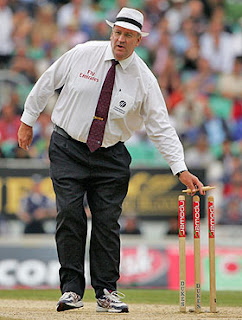
The Oval Cricket Ground has had it’s fair share of controversy the last few years:

In 2005, England reclaimed the ashes in unusual circumstances when they drew the test match – the batsmen accepted the light on the final day such that they could not return to the field. The match was ended with the umpires ceremoniously removing the bails. If it was not to be a decisive moment of a series like the ashes it would not have warranted such a ceremony.


In 2006, Daryl Hair made the headlines in Pakistan’s tour of England where he accused the team of ball tampering. The outcome was the Pakistan team refusing to return to the pitch and for the first time in the history of the game, the match was defaulted to England. In a similar way, the bails were removed.
2007 was fairly uneventful, but 2008 gave us another story…
England vs New Zealand in the 4th ODi out of 5 last wednesday (25th June)
Chasing under 250, New Zealand are only just keeping up with the run rate as last remaining batsmen Grant Elliot drops the ball from Ryan Sidebottom by his feet. Sidebottom goes for the ball and there’s a nasty collision. Elliot falls, Bell picks up the ball, throws it to Pieteerson by the stumps who runs Elliot out.
Elliot hobbles off the pitch and is given out, and a whole uproar breaks out in the NZ dressing room. England lose the match in the end in a last ball cliff hanger. Collingwood apologises afterwards and the media lets loose.
At this point i will simply say make up your own mind:
link to the youtube video
To me I think the laws of the game are very clear with 2 exceptions
Apart from them, they say Elliot is out and Collingwood was right
The exceptions?
Firstly, the spirit of cricket – this is the prequel to the laws of the game, and are cricket’s way of saying you should show sportsmanship. Fair enough I say, but I still say tough luck in this instance.
Secondly, Law 23.3 & 42.5
Law 23.3 relates to when the ball is dead. Sub section (b) ii) says that when a player or umpire is injured the umpire should call dead ball.
Again, this is where if the umpire felt that the collision should’ve halted play he should’ve called dead ball. Instead he opted for the soft option and asked collingwood if he was sure he wanted to uphold the appeal. I’m sorry, but that doesn’t cut the mustard and isn’t the way to umpire.
Next, Law 42.5 which relates to obstruction of the batsman. This is the only law which could possibly save Elliot from dismissal. The laws are formatted such that it is up to the batsman to get from one end of the pitch to the other unless he is deliberately obstructed. Clearly this was not the case in this instance, and i would go so far as to say that both batsmen tried to get in the way of either the ball or the bowler or both. Why else would all 3 be running on the same side of the wicket. Elliot should’ve run down the left hand side since his partner was running down the other. But wait, that would’ve meant he couldn’t get in between the ball and the stumps if he did that! But that’s ok, and apparently in keeping with the spirit of the game 😉
You’d never guess that i was a bowler when I played the game – and of course one who begrudges how it seems to be a batsman’s game (Twenty 20, fielding restrictions, limited short balls, powerplays etc etc.)
Enough of my cynical talking, but I will leave you with one last clip to get you thinking from December 2006 between Sri Lanka and New Zealand. The number 11 batsman Mutthiah Muralitharan and Kumar Sangakarra completed a single which got Sangakarra to 100. Murali walks out of his crease to congratulate Sangakarra. Unwittingly, the ball is still on it’s way back and Brendon McCullum runs Murali out. Spirit of Cricket New Zealand?
Make up your own mind, but I say while the spirit of cricket lives there should still be some degree of common sense and responsibility.
